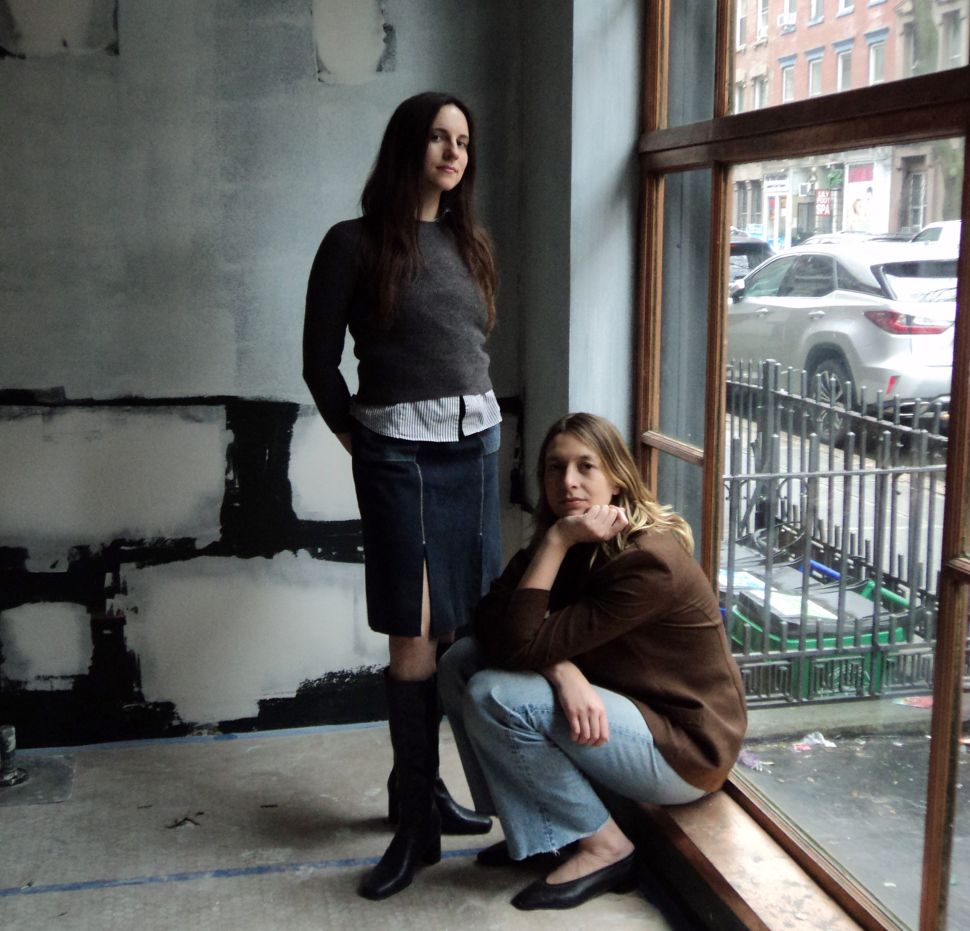Despite the tariff turmoil and a still sluggish art market, a new wave of galleries is debuting in New York this May during art week. Among them, Slip House stands out—not just for its name or location, but for the way both are mirrored in its model and mission. Co-founders Ingrid Lundgren and Marissa Dembkoski want to revive the pioneering spirit of the Coenties Slip artists—Agnes Martin, Ellsworth Kelly and James Rosenquist, among others—who once transformed the industrial East River Old Slip waterfront into a tight-knit creative enclave, running parallel to the rise of the downtown loft scene. With what they intend to be a similarly dynamic platform, Lundgren and Dembkoski aim to challenge the traditional gallery space and model by creating a welcoming, flexible domestic environment rooted in a strong sense of historical continuity.
“We have been wanting to find a place that was entrenched in history,” Dembkoski told Observer ahead of the opening, during the final stages of the building’s renovation. “When we first came across the building, there wasn’t much information, but this was the first and the last space we saw.” As soon as the duo walked in, they immediately sensed there must be a rich story tied to the structure and began digging into its past. The location turned out to have been the longtime studio and home of Charles Kritsky, a designer with deep roots in the 1980s downtown art scene. A close friend of Jean-Michel Basquiat, Kritsky created designs for Madonna, Billy Idol and Carolina Herrera.
With a boutique and studio on the ground floor and his apartment above, Kritsky hosted a rotating cast of downtown creatives, making the space as much a salon as it was a home. “We ended up learning how he was a really giving person—he would just invite everyone into his home,” Dembkoski said. “There was really a community around this space.” For Dembkoski and Lundgren, the building’s layered past—as carriage house, artist residence, and communal gathering point—is a foundation. “We see ourselves as stewards of this special space,” Lundgren added, underscoring their commitment to fostering an environment as generous and artist-responsive as its history suggests.
Dembkoski and Lundgren were also inspired by Isabella Stewart Gardner and her radical approach to opening her home and collection, first as a residency, then as a museum. “This idea of cultivating a community, coming together over meals and cultural exchanges, and really existing and living with the artwork truly inspired us,” Dembkoski said, noting how the traditional commercial format rarely creates space today to stay, linger, have a cup of tea and engage in more meaningful exchange and conversation.
SEE ALSO: From Storage to Spotlight – How D.C.’s National Gallery Is Redefining Access to Art
The founders’ decision to preserve domestic touches—such as a working fireplace and kitchen on the second floor—has been key to maintaining this community-oriented profile, encouraging slower, more intimate encounters with art. The third floor, meanwhile, has been envisioned as a live/work space, with plans for a rotating artist residency later in the gallery’s life. “The artist residency is part of our longer-term vision: we plan to house artists that we’re showing or artists who need to come into New York,” Dembkoski said. For the first year, she will reside onsite, enabling an even more flexible model for how they interact with both visitors and artists.
Both Ingrid Lundgren and Marissa Dembkoski bring years of experience in the art world to this new venture—Lundgren from the gallery business, Dembkoski from the museum sector. Dembkoski has worked across various institutional settings, contributing to marketing and partnerships for the Harvard Art Museums, the Saint Louis Art Museum and the Monira Foundation before launching her own small gallery in Glencoe, Illinois, Mae Lombardi. Lundgren is back in New York after running Winter Street Gallery on Martha’s Vineyard for five years.
The pair first met at a party in Los Angeles a few years ago and immediately hit it off, with similar tastes, interests and ethos. At the time, both were running galleries in comparable cultural and socio-demographic contexts and grappling with similar challenges. Additionally, both had been exploring curatorial formats that blurred the boundaries between generations, frequently showcasing emerging artists alongside more established ones. This commitment to weaving diverse voices into a fertile intergenerational dialogue now sits at the core of Slip House’s programming.
The inaugural exhibition, curated by former Sprüth Magers director Jessica Draper, includes historic works by Jack Whitten and Claude Viallat, shown alongside recent pieces by emerging names rising on the international scene, such as Oda Iselin Sønderland, Noelia Towers, Anne Hayden Stevens, Lizzy Gabay, Max Guy, Nour Malas, Katharina Schilling and Jill Tate, among others. Primarily on a smaller scale, the works are thoughtfully calibrated to the domestic, intimate spaces across the gallery’s three floors.
Working across multiple stages of the artists’ careers and price points, Lundgren and Dembkoski see their program as one that can speak to—and engage—diverse audiences: from seasoned collectors and institutional contacts to newer collectors who find the gallery’s flexible format more accessible and inviting.
The duo’s goal—at least in the gallery’s early years—is to foster collaborations rather than rep artists. “Our idea is to bring in outside curators to work with us and also collaborate with outside galleries, especially when it comes to estates,” Lundgren clarified. “We see ourselves as part of a generational shift. We want to reshuffle hierarchies, making some room for nuance.” Echoing her partner, Dembkoski added, “I think we both see a need to be able to have more intergenerational discourse—not only between artists but also between galleries.”

